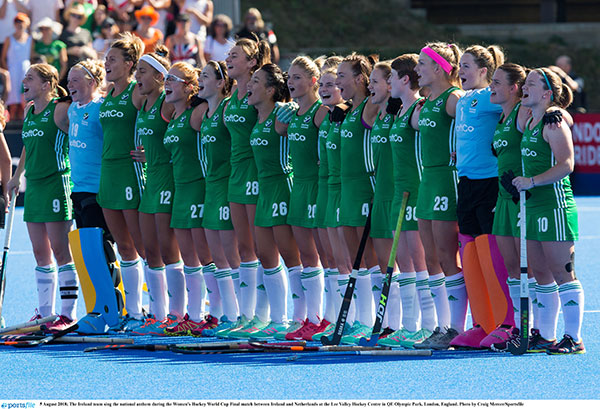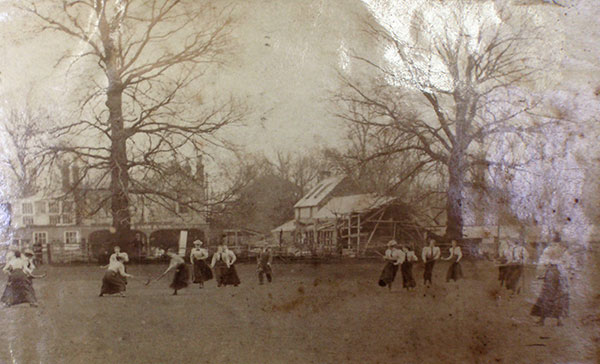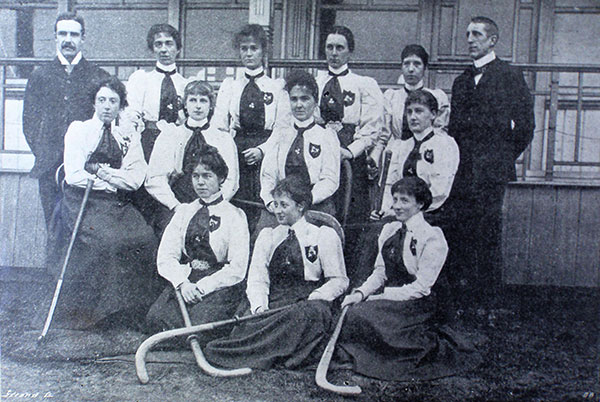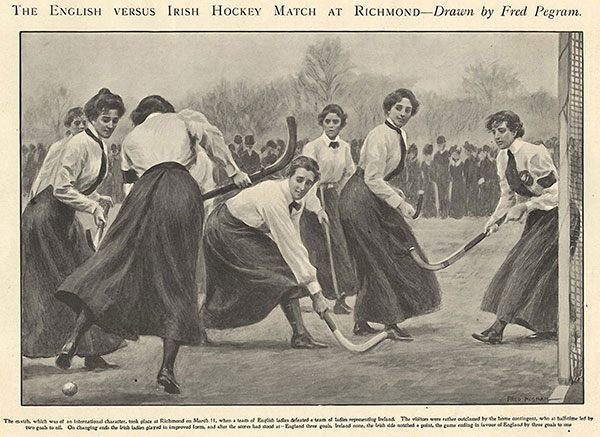Women’s hockey in Ireland—a short history
Published in 20th Century Social Perspectives, Features, Issue 5 (September/October 2018), Volume 26Field hockey has been played by women in Ireland for a little more than a century and a quarter. The Irish Ladies’ Hockey Union, instituted in 1894, was the first national organisation of the game in the world, and the first international match took place in Dublin two years later.
By John Lucey
The success of the Irish women’s team, in its battling performances to finish as runners-up against all the odds, at the Hockey World Cup in London this summer has brought the game into more prominence. What are its origins in Ireland?

Above: The Ireland team sings Ireland’s Call before facing the Netherlands in the Women’s Hockey World Cup final in London on 5 August 1918. (Craig Mercier/Sportsfile)
‘Hockey as a game for ladies has been played in Ireland since about the year 1892, and is daily becoming more popular.’ So wrote Laura Stephens (1875–1958) in 1899. In the same year, this Clontarf-born woman was awarded an MA by the Royal University of Ireland. She, along with other students at Alexandra College, had formed a hockey club in 1892. Alexandra at that time, as well as being a secondary school, prepared students for the degrees of the Royal University. Two of the lecturers there, Alice Lyster and Mary Story, had taken a keen interest in the game and were instrumental in its progress and organisation. Other clubs soon came into existence in the Dublin area, the next being the Merton club. A Newnham College, Cambridge, hockey team, made up of past and present students, visited Alexandra in January 1895 for a series of matches. The weather was inclement, with even some snow, but it did not spoil the festivities, during which the Irish ladies informed the visitors that they had started a ladies’ hockey union.

Above: Ireland playing East Molesey on the English tour in 1897, a game the visitors won 5–0. (Laura Stephens scrapbook, Alexandra College Library)
Irish Ladies’ Hockey Union
At the suggestion of Lyster and Story, on 22 October 1894 a meeting was held at Alexandra College of the women’s hockey clubs then in existence. Clubs represented at the meeting were Alexandra, Beechfield, Donnybrook, Dundrum, Howth Ladies and Merton. A resolution ‘that it would be advisable to form a Ladies’ Hockey Union on the same lines as the Men’s Hockey Union’ was passed unanimously and the Irish Ladies’ Hockey Union (ILHU) was formed. Thus came into existence the first national body of the women’s game worldwide. Its objective was to arrange two annual competitions (senior and junior) between the affiliated clubs, with the hope that an annual international match with England could also be organised.
The ILHU held its first AGM in February 1895, when details of the competitions were arranged and England was challenged to a match. The All England Ladies’ Hockey Association had been formed six months after the ILHU. The so-called English v. Irish (really an eleven from Alexandra) match took place in Brighton on 10 April 1895. Following that game, which ended in a scoreless draw, annual international matches between the two countries were put on a more formal basis, with the arrangement that they would take place alternately in London and Dublin.
International games
The first truly international match was played in Dublin in March 1896—a 2–0 win for Ireland. That first official Irish team consisted of Miss L. Martin (captain), Miss F. Martin, Miss F. Henshaw and Miss D. Johnson (ACD); Miss A. Boyd, Miss J. Boyd, Miss E. Obré and Miss M. Obré (Merton); Miss I. Shaw and Miss E. Bell (Donnybrook); and Miss E. Sealy (Dundrum).
The following March the Irish team travelled to England; Stephens played in goal and the match, played at Blackheath, ended in a scoreless draw. Her younger sister, Jane Stephens (1879–1959), who would go on to become a world-renowned zoologist, was first substitute, then aged just eighteen. When the team played in Oxford on the same tour the male students there were forbidden to watch the match, but some of the professors were present to see the Irish team triumph 3–0. They also played at the pioneering East Molesey Ladies’ Hockey Club, which had been started in 1887. Not a single goal was conceded by the Irish team on the English tour in 1897.
Ladies’ hockey in Ulster dates from c. 1896, when the clubs there united to form the Northern Ladies’ Hockey Union. Two years later it became affiliated with the senior union. The ILHU was then made up of eighteen clubs, ten from Ulster and eight from Leinster. In the same year, 1898, an English team again came to Dublin, and a match with Alexandra at the college grounds ended in a 3–0 defeat for the home team. The younger Stephens played at half-back that day; newspaper match reports included her among the most prominent players on the Irish side and asserted that had it not been for the fine performance by the elder Stephens in goal the score would have been much higher. In 1899 an international colours match (Whites v. Stripes) was played on the Merton ground, with the Stephens sisters on opposing sides, before the selected team went over to play England at Richmond, a match which the hosts won 3–1. In a terse report on the game for her Alma Mater’s in-house magazine, Stephens reflected on how the team ‘had the honour of being beaten by the all too muscular Sassenach’.

Above: The Irish team and officials at Richmond before the England game in April 1899, which ended in a 3–1 defeat for Ireland. Laura Stephens is standing at back, third from right. The Irish team consisted of Miss A. Boyd (captain), Miss J. Boyd, Miss H. Atthill, Miss E. Obré and Miss M. Obré (Merton); Miss E. Green, Miss D. Johnson and Miss L. Stephens (Alexandra College); Miss H. Barrington and Miss E. Sealy (Dundrum); and Miss L. Knox (Excelsior). (The Gentlewoman, 1 April 1899)
Following the AGM of the ILHU in 1899, an invitation had been sent to Wales for a game the following season, which was played on 20 February in Dublin. The Welsh Ladies’ section of the Welsh Association had been formed in 1898, while the Scottish Women’s Hockey Association was founded in 1900. Ireland were the first to play Wales, in 1900, and Scotland, in 1902.
In 1900 the annual international match with England was eventually played at Donnybrook, after being postponed when the Alexandra ground at Milltown was unplayable owing to the March weather. One newspaper reported that the pitch ‘is not at all a level one, and it is hard to expect English ladies, who play invariably on level ground at home, to show their true form here under such circumstances’. The ‘Saxon side’ prevailed nonetheless, winning 2–1. The two Stephens sisters also played for the ‘United Colleges’ (Alexandra College, Dublin, and Victoria College, Belfast) in a game against the visiting English XI which was able to go ahead at Milltown.
Dress code
The following general practical advice was given in 1899, by a leading male authority on the game in England, for women taking up the sport: ‘Every woman who takes up the game should, in the first instance, be able to bend, swing, stoop, and breathe with absolute ease’. This, of course, was a reference to the wearing of corsets, which he deemed ‘nothing short of an abomination’ on the hockey field.
In the very early days the Irish international team wore boater hats, blouses and ankle-length cloth skirts of St Patrick’s blue or dark green. Sailor hats, bonnets and caps were also among the styles of headgear donned by players. The shirt blouses were of cotton with pale green and white stripes and an embroidered shamrock on the breast pocket, worn with a long, dark green silk tie. The footwear varied from rubber shoes through leather boots and spats to shoes with gaiters. A rise of skirt length to five inches off the ground had been adopted for practical reasons in 1900. At the ILHU 1899 AGM, a resolution had been passed:
‘That the international skirts be COMPELLED to be of regulation length—i.e., 5 inches from the ground in order that the ball should not be so frequently lost to view as was at present the case’.
A few years later the skirts were raised to eight inches above the ground. In the early years some wore shin-guards, but even for goalkeepers there was nothing like the protection later afforded to those minding goal. Stephens recalled the very early days at Alexandra, when the original type of hockey sticks—really oak walking sticks with a long crook—were used for the initiation of the students into the new game. Over time the design of the hockey stick has changed, as has the attire worn.
In the 1930s new, more progressive ideas for women’s hockey outfits were emerging, such as wearing woollen plus-fours with a wrap-over skirt, arranged to open at the side for freedom of movement, or alternatively a matching gymslip and knickers in more lightweight material. By the 1950s, while practically every other country had adopted the divided skirt and knee-length socks, Ireland and Scotland still played their international matches in tunic and long stockings. This later changed, however, and the Irish women dressed in more practical attire, which has evolved over the years to that worn in the present day.

Above: England v. Ireland at Richmond in 1901, a 3–1 win for the home team. Over time both the hockey sticks and the dress code evolved. (Dublin City Library & Archive)
Lasting legacy
The game for women had developed very quickly, and as early as 1896 Alexandra had a first, second and third team playing matches not only against Dublin clubs but also as far away as Athy and Roscrea, as well as Victoria College in Belfast. Ladies’ hockey was strongest in Leinster, followed by Ulster, but by 1903 the two other provinces, Munster and Connaught, had joined the ILHU and a full round of interprovincial matches commenced. Five decades later the Union catered for more than 5,000 players. In October 1953 visiting women’s teams from Australia, South Africa and the United States had their first bully off on Irish soil.
It was not until almost 50 years later, in 2000, that the men’s and women’s unions amalgamated, becoming the Irish Hockey Association. Eighteen years on, the international women’s team reached the World Cup final. It has been a long journey for Irish women’s hockey, from its beginnings among a group of pioneering young women to a historic achievement 126 years later by a similar group of courageous young women. Laura Stephens wrote in 1897 about the trip to London, for the first away international match, of the young women from the various Irish clubs being ‘united in one common cause, and, if a little nervous as to the result, at least determined to back each other up to the very last’. It was this same strong determination and sense of camaraderie by a similar group of young Irish women that led to their success in the same city 121 years later. Perhaps, in the case of Irish women’s hockey, history does repeat itself!
Among the young foundresses of Irish women’s hockey at Alexandra College, along with Stephens, was Hilda Webb (1873–1940), who twenty years later, in 1912, was one of eight women arrested for throwing stones at government buildings in Dublin during protests by the militant Irish Women’s Franchise League. Stephens supported the movement but—perhaps because of her by then public service position—took a more backseat role, although she did publicly sign the petition for the release of the imprisoned Suffragists. Six years later the right to vote was granted to women. It is fitting that in this centenary year of women’s suffrage, when Irish women achieved unprecedented success, a brief history of their sport should be documented. It can certainly be said of these two women that they have left a lasting legacy.
John Lucey is a Kilkenny-based historian and author of The Irish pearl: a cultural, social and economic history (Wordwell Books, 2005).
Further reading
I.M., ‘Octogenarian’, Irish Independent, 7 February 1956.
P.D. MacWeeney, ‘Founding of the I.L.H.U.’, Irish Times, 3 April 1954.
J.N. Smith & P.A. Robson, Hockey: historical and practical (London, 1899).
L. Stephens, ‘The Irish team in England’, Alexandra College Magazine (June 1897).
















